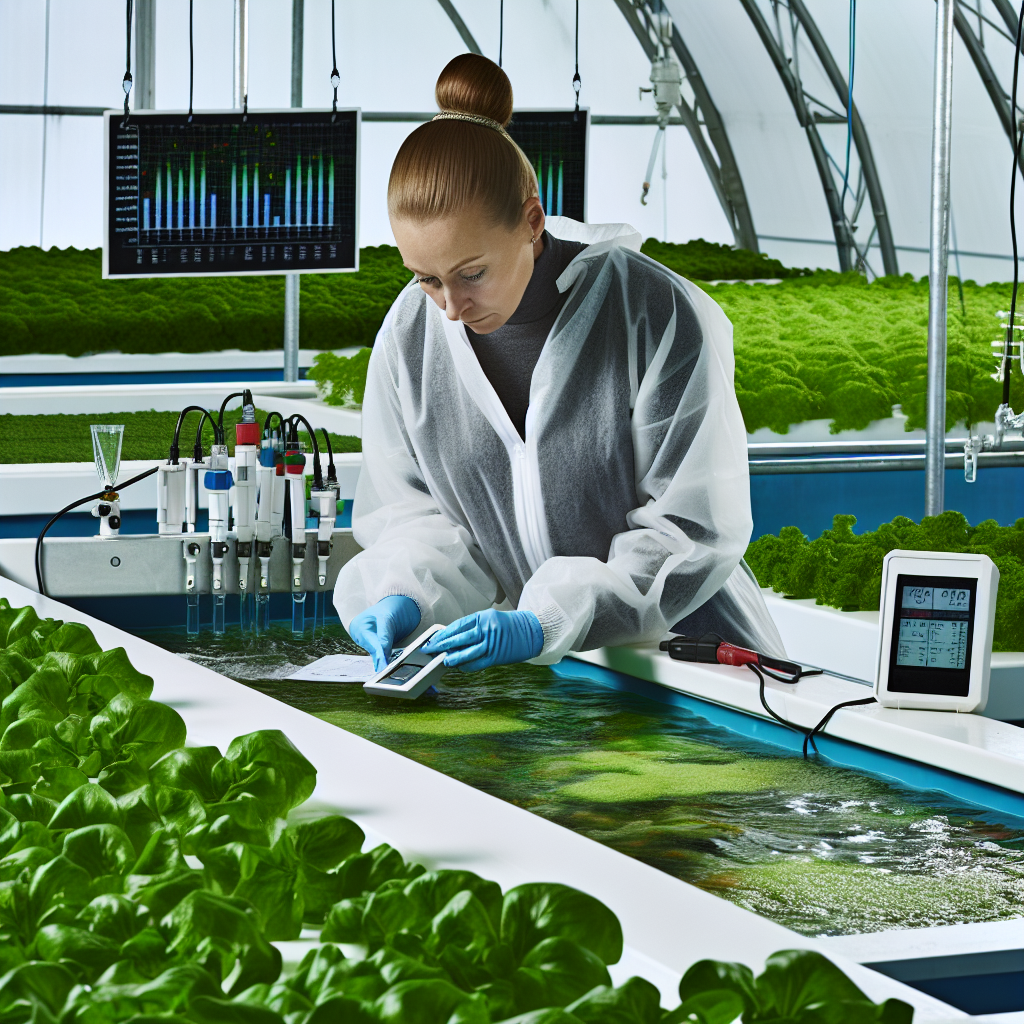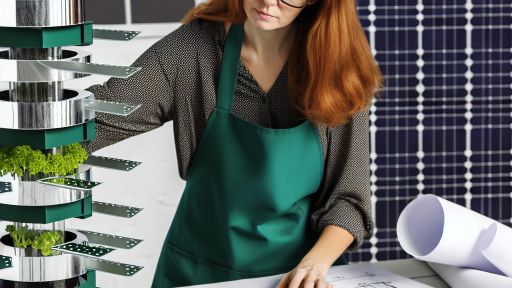Understanding the Importance of Water Quality in Aquaponics
Fundamental Role of Water Quality
Water quality plays a crucial role in aquaponics systems.
It directly impacts fish health, plant growth, and system stability.
Fish require clean water for optimal growth and reproduction.
In addition, plants thrive in balanced nutrient-rich water.
Overall, high water quality fosters a healthy aquaponics ecosystem.
Impact on Fish and Plant Health
Fish health deteriorates rapidly in poor water conditions.
Common issues include stress, disease, and even mortality.
Moreover, plants absorb nutrients through water.
Subpar water quality limits nutrient availability for plants.
Thus, it can hinder their growth and yield.
Maintaining Optimal Water Parameters
Monitoring water parameters is essential for aquaponic systems.
Key factors include pH, ammonia, nitrites, and nitrates.
Maintaining a stable pH is crucial.
Typically, an optimal pH range lies between 6.5 and 7.5.
Additionally, ammonia levels should remain near zero for fish safety.
Transform Your Agribusiness
Unlock your farm's potential with expert advice tailored to your needs. Get actionable steps that drive real results.
Get StartedStrategies for Improving Water Quality
Several strategies can enhance water quality in aquaponics.
- Regular water testing promotes informed decision-making.
- Using biofiltration systems helps remove waste products.
- Implementing aeration improves oxygen levels in water.
- Regular water changes can dilute harmful substances.
Pest and Disease Management
Healthy water quality helps prevent pest infestation and disease outbreaks.
Lower stress levels enhance fish immunity.
This results in fewer diseases that could spread to plants.
Additionally, clean water reduces the risk of waterborne pathogens.
Importance of Long-Term Water Quality Maintenance
Maintaining water quality is vital in aquaponics.
It secures the health of both fish and plants.
Furthermore, it ensures long-term system sustainability.
Key Parameters for Measuring Water Quality
Understanding pH Levels
pH is a crucial parameter in aquaponics systems.
It measures the acidity or alkalinity of the water.
Most aquaponic systems thrive at a pH between 6.5 and 7.5.
Regularly testing pH can prevent harmful fluctuations.
Use a reliable pH meter or test strips for accuracy.
Monitoring Ammonia Concentrations
Ammonia originates from fish waste and uneaten food.
High levels of ammonia can quickly become toxic to fish.
Test ammonia levels frequently, especially in new systems.
Maintain ammonia levels below 0.5 mg/L for fish safety.
Bacterial processes in biofilters help convert ammonia into less harmful substances.
Tracking Nitrate Levels
Nitrates are a vital nutrient for plants in aquaponics.
They result from the breakdown of ammonia through nitrification.
Optimal nitrate levels are generally between 5 mg/L and 100 mg/L.
Excessive nitrates can harm fish health.
Periodic testing will aid in maintaining balanced nitrate levels.
Assessing Nitrite Concentrations
Nitrite is also produced during nitrification and can be harmful.
Showcase Your Farming Business
Publish your professional farming services profile on our blog for a one-time fee of $200 and reach a dedicated audience of farmers and agribusiness owners.
Publish Your ProfileConcentrations should always remain at zero for fish safety.
High nitrite levels can indicate problems with the nitrogen cycle.
Regular testing helps detect issues early on.
Efficient biofiltration systems are essential to control nitrite levels.
The Role of Beneficial Bacteria in Aquaponics Systems
Importance of Beneficial Bacteria
Beneficial bacteria play a crucial role in aquaponics systems.
These microorganisms contribute to the nitrification process.
They convert harmful ammonia into nitrites and then into nitrates.
As a result, they help maintain safe water quality for fish and plants.
Moreover, they enhance nutrient availability in the system.
Types of Beneficial Bacteria
Several types of beneficial bacteria exist in aquaponics systems.
Nitrosomonas bacteria oxidize ammonia into nitrites.
Then, Nitrobacter bacteria further convert nitrites into nitrates.
Furthermore, other bacteria assist in breaking down organic matter.
This breakdown helps prevent toxic buildup in the water.
Creating a Favorable Environment
Providing a suitable environment is essential for beneficial bacteria.
They thrive in specific temperature and pH ranges.
Generally, temperatures between 20°C and 30°C promote their growth.
Additionally, maintaining a pH between 6.5 and 7.5 is ideal.
Regularly testing water parameters aids in sustaining these conditions.
Maintaining Bacterial Populations
To ensure a healthy balance of bacteria, consider various measures.
First, avoid using chemical treatments that may harm them.
Second, introduce a diverse range of bacteria using supplements.
Some aquaponics farmers utilize commercial bacterial inoculants.
Finally, consistent water circulation supports bacterial colonies.
Monitoring and Troubleshooting
Regular monitoring of bacterial activity is vital in aquaponics.
Test for ammonia, nitrite, and nitrate levels frequently.
Elevated ammonia levels may indicate insufficient bacterial populations.
In contrast, high nitrite levels suggest a need for intervention.
Identifying problems early ensures system stability and productivity.
Gain More Insights: Heirloom Gardening Techniques for Small Farms
Common Water Quality Issues in Aquaponics
pH Imbalance
pH level plays a critical role in aquaponics systems.
Most fish thrive in water with a pH between 6.5 and 7.5.
On the other hand, plants prefer a slightly more acidic environment.
Regular pH testing helps identify imbalances.
To adjust pH, use pH up or down products as needed.
Ammonia and Nitrite Toxicity
Ammonia is toxic to fish at high levels.
It originates from fish waste and uneaten food.
Nitrites are concerning as well, as they can accumulate.
Regular monitoring of ammonia and nitrite levels is essential.
To reduce these compounds, ensure proper filtration is in place.
Showcase Your Farming Business
Publish your professional farming services profile on our blog for a one-time fee of $200 and reach a dedicated audience of farmers and agribusiness owners.
Publish Your ProfileAdditionally, introduce beneficial bacteria to help with breakdown.
Low Dissolved Oxygen
Oxygen is vital for fish and plant health.
Low levels can stress fish and hinder plant growth.
Factors like temperature and water movement affect oxygen levels.
Use aeration devices to increase dissolved oxygen.
Regularly check water temperature to maintain optimal conditions.
High Nitrate Levels
Nitrate levels can build up over time in aquaponic systems.
While fish can tolerate some nitrates, plants use this as a nutrient.
Excessive nitrates can lead to algae blooms.
Regular water changes help manage nitrate concentrations.
Additionally, consider adding plants that uptake nitrates effectively.
Temperature Fluctuations
Temperature impacts fish metabolism and plant growth.
Most aquatic species thrive between 70 to 75 degrees Fahrenheit.
Extreme fluctuations can cause stress and decrease yields.
Install heaters or chillers as needed to stabilize temperatures.
Additionally, shade cloths can help regulate temperature as well.
Contaminants and Chemicals
Water sources may contain harmful contaminants.
These can impact both fish and plant health.
Regular testing ensures water quality remains safe.
Using clean, filtered water is crucial for system health.
Consider employing carbon filters to remove chemical residues.
Delve into the Subject: Innovative Hydroponic Techniques for Farmers
Techniques for Regular Water Testing and Monitoring
Importance of Water Quality in Aquaponics
Water quality is crucial for successful aquaponics systems.
Healthy fish and plants depend on balanced water chemistry.
Regular monitoring prevents nutrient imbalances and disease outbreaks.
Moreover, proper maintenance fosters a sustainable ecosystem.
Choosing Appropriate Testing Kits
Select high-quality testing kits for accurate results.
Consider pH, ammonia, nitrite, and nitrate testing options.
For beginners, liquid test kits are user-friendly.
Advanced users may prefer digital meters for precision.
Establishing a Testing Routine
Create a regular schedule for water testing.
Daily check-ups ensure early detection of issues.
Weekly testing can provide a comprehensive overview.
Adjust the frequency based on system changes.
Monitoring Visual Indicators
Pay attention to fish behavior and plant health.
Unusual activity may indicate water quality problems.
Yellowing leaves may signal nutrient deficiencies.
Regular observations can complement test results.
Using Technology for Monitoring
Consider investing in automated testing devices.
These systems track parameters continuously.
Showcase Your Farming Business
Publish your professional farming services profile on our blog for a one-time fee of $200 and reach a dedicated audience of farmers and agribusiness owners.
Publish Your ProfileNotifications alert you to any drastic changes.
Utilize apps for analytics and data storage.
Documenting Water Quality Data
Keep a detailed log of water parameters over time.
Documenting helps identify trends and recurring issues.
This information assists in fine-tuning your system.
Regular reviews of data enhance decision-making.
Uncover the Details: Heirloom Gardening Tools Every Farmer Needs
Filtration Methods: Types and Their Effectiveness in Maintaining Water Quality
Introduction to Water Filtration in Aquaponics
Water quality is vital for both plants and aquatic life in aquaponics systems.
Effective filtration methods remove harmful substances from the water.
They also ensure that nutrients remain available for plant growth.
Mechanical Filtration
Mechanical filtration acts as the first line of defense in aquaponics.
This method involves physically removing solids from the water.
Common types include mesh screens and sedimentation tanks.
Mesh screens filter large particles effectively.
Meanwhile, sedimentation tanks allow solids to settle and separate.
Advantages of Mechanical Filtration
Mechanical filtration is straightforward and cost-effective.
It requires minimal maintenance, making it user-friendly.
Additionally, it enhances the overall water clarity.
Biosand Filters
Biosand filters combine mechanical and biological processes.
This method captures particles while allowing beneficial bacteria to thrive.
These bacteria help break down organic matter in the water.
Benefits of Biosand Filters
Biosand filters improve water quality sustainably.
They reduce reliance on chemical treatments.
Moreover, they enhance the health of both plants and fish.
Chemical Filtration
Chemical filtration utilizes specific substances to remove impurities.
Activated carbon is a common material used for this purpose.
It effectively eliminates chlorine and undesirable odors.
Effectiveness of Chemical Filtration
Chemical filtration is essential for maintaining optimal water quality.
It can improve the overall health of the aquaponics ecosystem.
Adding Biological Filters
Biological filtration plays a crucial role in an aquaponics system.
This method uses beneficial bacteria to convert ammonia to nitrites.
Then, it transforms nitrites into nitrates, which plants can absorb.
Advantages of Biological Filters
Biological filters create a self-sustaining environment for aquaponics.
They contribute to the overall balance of the ecosystem.
Furthermore, they can reduce fish stress and mortality rates.
Choosing the Right Filtration System
Selecting a filtration system depends on the scale and type of aquaponics setup.
Consider factors such as water volume and desired fish and plant species.
An integrated approach combining various filtration methods often yields the best results.
Key Considerations
- Assess the water quality and specific needs of your system.
- Evaluate the cost and maintenance requirements of each method.
- Plan for potential upgrades as the system grows.
You Might Also Like: Essential Nutrients for Hydroponic Growth

Water Change Practices
How Often to Change Water
Regular water changes are crucial for maintaining aquaponics systems.
Showcase Your Farming Business
Publish your professional farming services profile on our blog for a one-time fee of $200 and reach a dedicated audience of farmers and agribusiness owners.
Publish Your ProfileFrequency depends on various factors including system size and fish load.
Smaller systems may require changes every week.
In larger systems, bi-weekly or monthly changes could suffice.
Assessing water parameters helps determine the right frequency.
How Much Water to Change
Changing too much water at once can disrupt the ecosystem.
A typical recommendation suggests changing 10% to 20% of the water.
Monitor the water’s pH, ammonia, and nitrite levels frequently.
If levels spike, consider larger changes temporarily.
Over time, adjusting the quantity becomes necessary based on plant growth and fish health.
Best Practices for Water Changes
Always use dechlorinated water for changes.
This prevents harm to beneficial bacteria in the system.
Introduce new water slowly to minimize temperature shock.
Testing water parameters before and after changes is vital.
Documenting these changes can help spot trends over time.
Using Water Change to Manage Nutrients
Water changes can effectively manage nutrient levels in aquaponics systems.
High nutrient levels can lead to algae blooms and harm fish.
Regular changes help maintain optimal nutrient levels for plant growth.
Balancing nutrient delivery ensures healthy plants and robust fish.
Time the changes around plant feeding schedules for maximum efficiency.
Balancing Fish Stocking Density with Water Quality Management
Understanding Stocking Density
Stocking density refers to the number of fish in a given water volume.
It affects both fish health and water quality parameters.
Overcrowding can lead to stressed fish and deteriorating water conditions.
Conversely, too few fish can limit nutrient production for plants in aquaponics.
Impacts of Stocking Density on Water Quality
Higher stocking densities increase waste production significantly.
This waste leads to elevated ammonia levels in the water.
Ammonia is toxic to fish and must be managed effectively.
Moreover, it can result in reduced dissolved oxygen levels.
Low oxygen levels can further stress the fish stock.
Strategies for Managing Stocking Density
Regular monitoring of water quality is essential.
Test for parameters such as ammonia, pH, and nitrate levels.
Implement removal of excess fish if water quality declines.
Ensure adequate filtration to handle waste produced by fish.
Consider species that grow well together in a shared environment.
Balancing Nutrient Contribution
Fish contribute nutrients that are beneficial to plant growth.
Balancing fish and plant ratios promotes water quality and biodiversity.
Strive for an optimal fish-to-plant ratio for maximum efficiency.
Healthy fish produce organic matter, aiding plant nutrition.
Monitoring and Adjusting Stocking Density
Regularly assess fish health and growth rates.
Adjust stocking density based on fish performance and plant needs.
Utilize feedback from water quality tests to make necessary changes.
Showcase Your Farming Business
Publish your professional farming services profile on our blog for a one-time fee of $200 and reach a dedicated audience of farmers and agribusiness owners.
Publish Your ProfileA proactive approach ensures a sustainable aquaponics system.
Ultimately, striving for balance leads to thriving ecosystems.
Exploring Water Treatment Options
UV Sterilization
UV sterilization uses ultraviolet light to kill harmful microorganisms.
This method effectively reduces bacteria and viruses in the water.
It operates without chemicals, ensuring a safe environment for fish and plants.
Moreover, UV sterilizers are straightforward to install and maintain.
Keep in mind that they require regular bulb replacements for optimal performance.
Chemical Treatments
Chemical treatments involve the use of specific substances to purify water.
Chlorine is a common choice, as it effectively disinfects water.
However, caution is necessary as it can harm aquatic life if not used correctly.
Another option is hydrogen peroxide, which degrades quickly in water.
Always follow recommended dosages to minimize risks to your aquaponics system.
Natural Alternatives
Natural alternatives provide an eco-friendly way to maintain water quality.
One popular method is using beneficial bacteria to outcompete harmful pathogens.
Adding organic materials, like compost, can enhance microbial diversity.
Plants, particularly water hyacinths, help filter water and absorb excess nutrients.
Consider using natural treatments to reduce reliance on chemicals.
Implementing Treatment Methods
Identifying Your System’s Needs
Start by assessing the specific needs of your aquaponics system.
Test the water regularly to determine pH and nutrient levels.
This information helps choose the right treatment for your setup.
Integrating Treatments
Many aquaponics systems benefit from a combination of treatment methods.
For instance, coupling UV sterilization with beneficial bacteria enhances purification.
Evaluate each method’s effectiveness to find a balance that suits your needs.
Monitoring Water Quality
Continuous monitoring is crucial for maintaining optimal water quality.
Utilize testing kits to regularly check water parameters.
These tests provide insights into the system’s health and treatment efficacy.
Adjust your strategies as necessary based on test results.
Additional Resources
Is Vertical Farming a Good Idea? No. It’s largely, though not entirely …
Sustainable Agriculture Methods: Benefits of Aquaponics – ECOLIFE …




